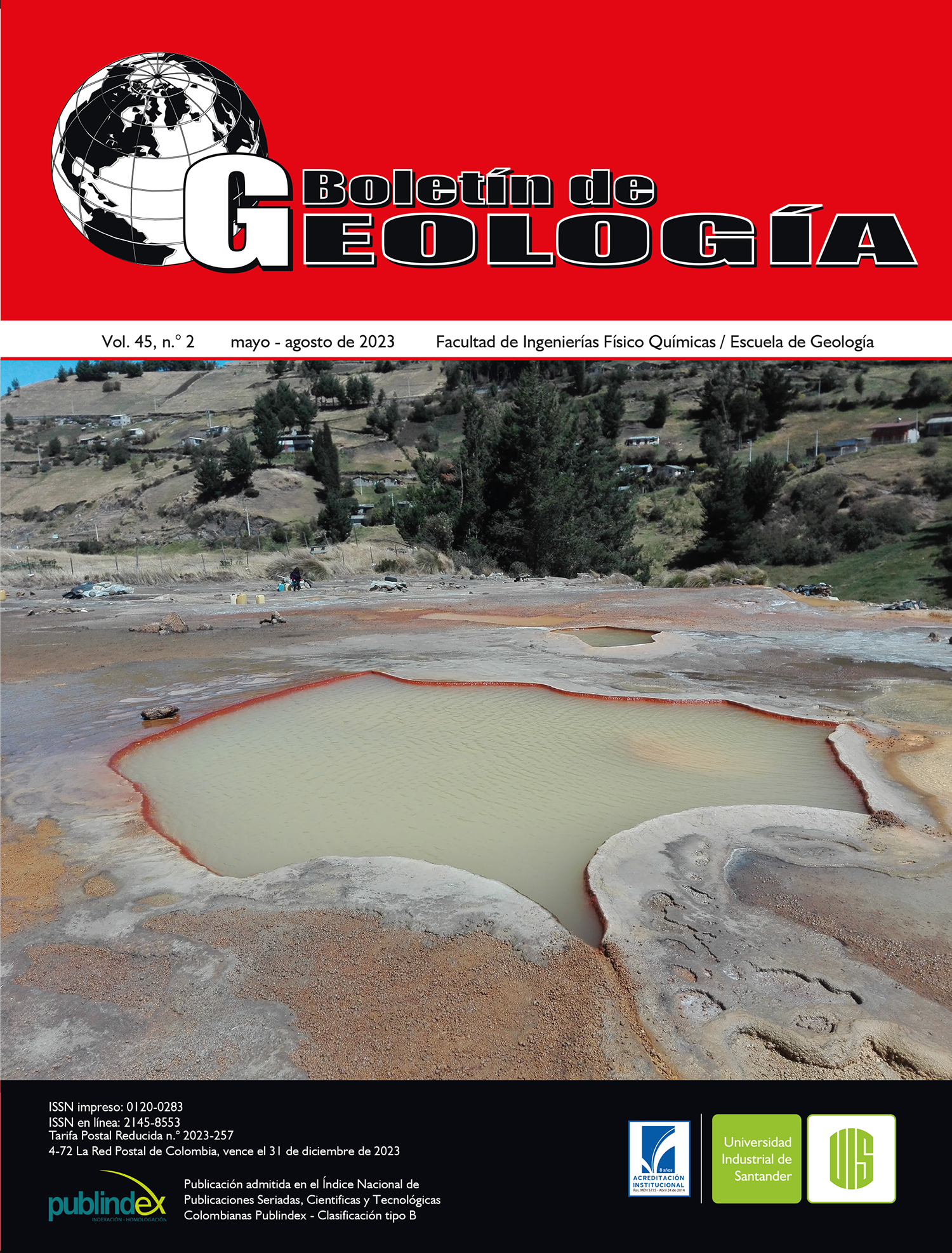Contributions to the investigation of the geothermal system of the Azufral volcano in Colombia through 2D magnetotelluric models
Published 2023-06-15
Keywords
- Magnetotelluric of Azufral Volcano,
- Azufral Geothermal System,
- TDEM,
- Diabasic Group Basement
How to Cite
Copyright (c) 2023 Boletín de Geología

This work is licensed under a Creative Commons Attribution 4.0 International License.
Altmetrics
Abstract
This work presents the modeling of the resistive structure of the subsoil for the geothermal area of the Azufral Volcano. The structure was adapted according to magnetotelluric soundings (MT) and from the information processing acquired in 140 MT stations, whose average recording times were 24 hours. These allowed to obtain data from 104 to 10-2 Hz and 39 transient soundings (TDEM) have also been carried out to control the displacement of static shift. 2D inversions have made possible to determine that the resistive structure of the area is characterized by focus of conductive anomalies between 1-10 Ω·m, intermediate between 10-100 Ω·m and resistive zones with values >100 Ω·m. The superficial resistive anomalies with thicknesses of 200 to 500 m were associated with unaltered pyroclastic deposits and the deep ones with thicknesses of more than 4 km to the basement, which in the research area would correspond to the Diabasic group. The zones of conductive anomalies, which extend laterally throughout the study area with an approximate thickness of 2 km are associated with clayey layers that would form the seal of the geothermal system. The anomalies with intermediate values may be due to variations in the temperature of the geothermal system, creating minerals of different conductivity such as Illite, biotite, and chlorite, among others.
Downloads
References
- Ariana Ltda. (2009). Informe Final operaciones de campo Proyecto Magnetotelúrica Tumaco, Nariño.
- Bahr, K. (1988). Interpretation of the magnetotelluric impedance tensor: regional induction and local telluric distortion. Journal of Geophysics, 62, 119-127.
- Bahr, K. (1991). Geological noise in magnetotelluric data: a classification of distortion types. Physics of the Earth and Planetary Interiors, 66(1-2), 24-38. https://doi.org/10.1016/0031-9201(91)90101-M
- Barrero, D. (1979). Geology of the Central Western Cordiller West of Buga and Roldanillo Colombia. Publicaciones Geológicas Especiales del Ingeominas, No. 4, Bogotá.
- Bechon, F.; Monsalve, M.L. (1991). Activité récente préhistorique du volcán Azufral (S-W de la Colombie). Journal of Volcanology, 99-104.
- Fontaine, E. (1994). Évolution volcanologique et géochímique du volean Azufral, Colombie, Amérique du Sud. Tesis de Maestría. Université de Montréal, Canadá.
- González, H.; Zapata G.; Montoya, D. (2002). Geología y Geomorfología de la plancha 428 Túquerres. INGEOMINAS, Medellín.
- Groom, R.; Bailey, R. (1989). Decomposition of magnetotelluric impedance tensors in the presence of local three-dimensional galvanic distortion. Journal of Geophysical Research, Solid Earth, 94(B2), 1913-1925. https://doi.org/10.1029/JB094iB02p01913
- Jones, A.M.; Jödicke, H. (1984). Magnetotelluric transfer function estimation improvement by a coherence-based rejection technique. SEG Technical Program Expanded Abstracts, 51-55. https://doi.org/10.1190/1.1894081
- Layugan, D.; Rigor, D.; Apuada, N.; Los Baños, C.; Olivar, R. (2005). Magnetotelluric (MT) Resistivity surveys in various geothermal systems in Central Philippines. World Geothermal Congress, Antalya, Turkey.
- Martí, A.; Queralt, P.; Jones, A.; Ledo, J. (2005). Improving Bahr’s invariant parameters using the WAL approach. Geophysical Journal International, 163(1), 38-41. https://doi.org/10.1111/j.1365-246X.2005.02748.x
- McNeice, G.; Jones, A. (2001). Multisite, multifrequency tensor decomposition of magnetotelluric data. Geophysics, 66(1), 158- 173. https://doi.org/10.1190/1.1444891
- Miensopust, M.; Jones, A.; Muller, M.R.; García, X.; Evans, R.L. (2011). Lithospheric structures and Precambrian terrane boundaries in northeastern Botswana revealed through magnetotelluric profiling as part of the Southern African Magnetotelluric Experiment. Journal of Geophysical Research, Solid Earth, 116(B2). https://doi.org/10.1029/2010JB007740
- Ortiz, O. (2013). Sismotectónica y peligrosidad sísmica en Ecuador. Tesis de maestría. Universidad Complutense de Madrid, España.
- Pachón, M. (2006). Proyecto de investigación sísmica, geológica y geotérmica en el altiplano nariñense. Análisis de patrones de fracturamiento en el altiplano nariñense, tomo II. Convenio interinstitucional 046/2005. INGEOMINAS, Bogotá.
- Parkinson, W.D (1959). Directions of rapid geomagnetic fluctuations. Geophysical Journal International, 2(1), 1-14. https://doi.org/10.1111/j.1365-246X.1959.tb05776.x
- Pinilla, A.; Ríos, P.; Rodríguez, B.; Roa, H.; Ladino, F. (2006). Mapa geológico altiplano Nariñense. INGEOMINAS, Bogotá.
- Rodríguez, G.; Rueda-Gutiérrez, J. (2017). Geología estructural del área geotérmica del volcán Azufral, Informe. Servicio Geológico Colombiano, Bogotá.

